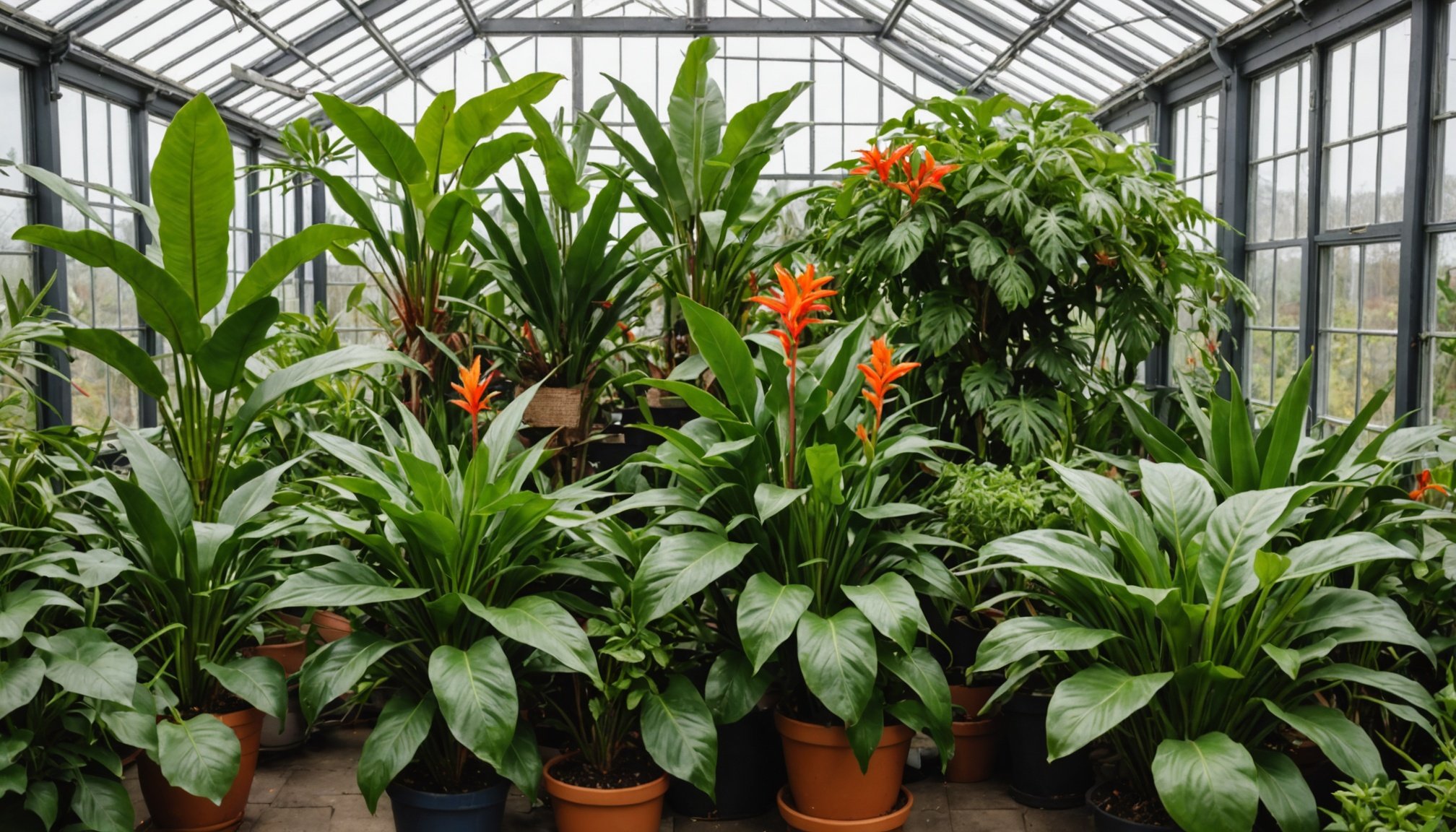Understanding Exotic Plants and Their Needs
Caring for exotic plants indoors requires a good grasp of specific care requirements unique to each species. These indoor plant requirements can vary widely depending on the plant type. Recognizing and adapting to these needs is crucial for thriving indoor environments, particularly in overwintering conditions.
Popular Exotic Plants for Indoor Overwintering
Among the array of exotic species, some popular examples for indoor overwintering include the Bird of Paradise, Fiddle Leaf Fig, and Orchid. Each of these plants showcases remarkable aesthetics but also demands particular attention to care and environment.
Also to see : Unlocking the Secrets to Thriving Winter Gardening in the UK”s Chilly Climate
Specific Care Requirements
-
Bird of Paradise: Requires bright, indirect sunlight and moderate humidity. Ensure the soil stays slightly moist.
-
Fiddle Leaf Fig: Thrives with consistent, indirect sunlight and requires regular pruning to manage its size.
Also to see : Enhancing Vegetable Harvests: The Impact of Companion Planting in UK Allotments
-
Orchid: Demands a balance of humidity and some direct morning sunlight, along with a precise watering schedule to avoid root rot.
Importance of Recognizing Plant Needs
When dealing with exotic plants, it’s essential to tailor care to their individual plant species needs. This customized approach not only improves plant health but significantly enhances their ability to flourish throughout different seasons, particularly critical during colder months.
Preparing Your Home for Overwintering
When planning home preparation for overwintering, it’s essential to assess your indoor space and available light for plant placement. Begin by evaluating the rooms with the most natural light exposure. Plants thrive in well-lit areas, so position them near windows that receive ample sunlight. Consider using grow lights in rooms where natural light is insufficient.
Controlling your indoor environment is crucial. Focus on maintaining the right temperature, humidity, and airflow. Most plants prefer temperatures between 18-24°C. Use thermostats to ensure consistent warmth and reposition plants away from drafty spots.
Humidity is another critical factor. Central heating can dry out indoor air, affecting plant health. Consider using a humidifier to maintain humidity levels of 40-60%. This creates a conducive environment for plant growth, preventing leaves from drying out.
Effective airflow is essential to prevent mold and fungal issues. Ensure good ventilation in your home by occasionally opening windows or using fans. Adjust the direction of airflow to avoid direct drafts on plants, which can be detrimental.
By preparing your indoor environment carefully and considering these factors, you can help your plants thrive during the winter months.
Step-by-Step Overwintering Process
Managing plant overwintering steps ensures your green companions survive and thrive through the colder months. Successful seasonal care begins with understanding your plants’ needs.
Pre-Winter Preparations
Initiate preparations before temperatures plummet. Start by inspecting for pests. Remove discrepancies to prevent indoor infestations. Clean foliage with mild soapy water, focusing on leaf undersides.
Adjusting Water and Fertilization
Altering the watering schedule is crucial. Reduce hydration gradually, mimicking nature’s dormancy. Plants require less water as they enter a restful state. Consequently, decrease volumes to prevent root rot. Likewise, curtail fertilization. During winter, growth decelerates, so supplemental nutrients aren’t necessary until spring resumes.
Placement and Arrangement of Plants
Decide on optimal indoor placement. Light-loving species need bright, indirect sunlight, while shade-tolerant varieties can thrive with limited exposure. Gradually acclimate plants to indoor temperatures by transitioning them over several days.
Should an unfamiliar question arise like, “How can pest prevention methods be implemented effectively?” the answer is: Regular inspection remains key. Insulating plants from outdoor pests requires diligence. Outdoor-to-indoor transition often shelters pests unnoticed. Hence, preventative care and constant vigilance ensure healthy, vibrant plants during the winter zone. Hence, adopting a methodological approach to maintain plants accordingly is essential for winter survival.
Monitoring and Maintenance
Establishing a maintenance routine for your plants is crucial to sustaining their health and vitality. A comprehensive care schedule should include regular checks on plant health and environmental conditions. This means taking the time to observe your plants weekly, ensuring they receive the right amount of light, humidity, and moisture. A simple way to implement a plant monitoring routine is by setting reminders for watering, fertilising, and plant inspection.
When plant monitoring, pay attention to signs of stress such as discolouration, wilting, or pest infestations. Identifying these issues early helps in taking corrective measures before more significant damage occurs. For instance, yellowing foliage can signal either overwatering or nutrient deficiencies.
To maintain optimal conditions, focus on achieving the correct balance of humidity and moisture. Humidity can be managed by misting plants regularly or using a humidifier, especially in drier environments. Measure soil moisture using a moisture meter, and adjust watering schedules accordingly to prevent over- or under-watering.
A thoughtful maintenance routine not only boosts plant growth but also contributes to a healthier living space. By proactively managing plant health, potential stressors can be minimised, allowing plants to flourish.
Troubleshooting Common Issues
Caring for plants can sometimes be tricky, especially when you’re dealing with unexpected plant care problems. These can stem from pests, diseases, or environmental stress, and knowing how to identify and address these issues is vital.
Identifying Pests and Diseases
To manage pests and diseases effectively, begin by closely inspecting your plants. Common pests like aphids, spider mites, and mealybugs often hide on the undersides of leaves. You should look for signs such as discolouration, holes in leaves, or a sticky residue that may indicate a pest infestation. Detecting diseases requires noticing changes in leaf colour, wilting, or unexpected fungal growth.
Pest control is crucial; using natural remedies like neem oil or insecticidal soap can help eliminate these invaders. Meanwhile, maintaining good air circulation and not overwatering can prevent many diseases.
Solutions for Common Winter Problems
Winter months can bring unique challenges due to lower light levels and humidity. Environmental incompatibilities may cause stress, leading to leaf drop or stunted growth. Solutions involve positioning plants near south-facing windows and using humidifiers.
When to Seek Professional Help
Sometimes, disease management goes beyond home solutions. If plants experience severe wilting, extensive pest damage, or persistent diseases, it might be time to consult a professional.
Best Practices for Specific Exotic Plants
When nurturing exotic plants, it’s crucial to follow plant-specific care routines. Not all species thrive under the same conditions, making understanding and applying specific species guidelines essential. Exotic plants often require targeted maintenance to flourish, particularly in climates that differ from their natural habitats.
Tailoring your approach can be rewarding. Begin with species-specific guidelines that outline light, watering, and temperature needs. For instance, tropical plants generally demand high humidity, while succulents lean towards minimal moisture and optimal light. Ignoring these directives can lead to suboptimal growth or even plant failure.
Consider case studies of successful overwintering techniques for exotic plants. Many enthusiasts have transformed basements or spare rooms into small-scale greenhouses using artificial light and temperature control, proving it a viable solution for year-round indoor plant thriving.
Additionally, not all exotic plants enjoy exposure. Take, for example, the Calathea, a lesser-known species. It thrives indoors during winter due to its preference for moderate light and cooler temperatures. Understanding such characteristics can significantly enhance your indoor garden’s success, making plant care less daunting and more enjoyable.
By following tailored maintenance and species-specific care, you ensure each plant receives the optimal environment to display its vibrant potential.
Additional Resources and Reading
For those eager to dive deeper into plant care, numerous resources can bolster your knowledge. Books, blogs, and websites are plentiful, with each offering expert advice tailored to varying levels of gardening expertise.
Start by exploring books such as “The Gardener’s Companion” and “Plant Parenting.” These texts provide comprehensive guidance and foster an understanding of plant care essentials. Blogs like “The Houseplant Journal” offer up-to-date tips and inspire both novice and seasoned gardeners.
Digital spaces simmer with plant periodicals and advice columns as well. Websites such as the “Royal Horticultural Society” offer a repository of information on plant varieties and care techniques. For community interaction, online forums such as “UK Plant Enthusiasts” forge connections between amateur and professional gardeners alike. Such platforms facilitate the exchange of tips and support across the plant-loving spectrums.
The United Kingdom is home to myriad local gardening resources. Direct contact with expert gardening professionals can be established through events like plant fairs or nursery tours. Some recommended venues include the Chelsea Physic Garden and Kew Gardens, both offering guidance and hosting workshops throughout the year. These interactions are invaluable, providing hands-on experience and expert situations.











